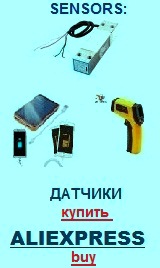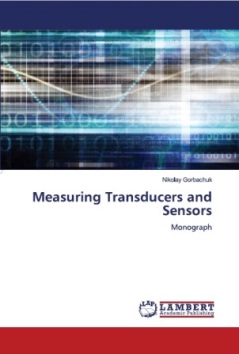Transducers, gauges, sensors - Information portal © 2011 - 2023 Use of material is possible by placing an active link
Thermistors . Resistance thermometer. Principle of operation
Thermistor - a semiconductor device ( it is made of semiconductor material with a large negative temperature coefficient ), which uses the electrical resistance of the semiconductor temperature.
Change the resistance Rt semiconductor temperature change is characterized by dependence:
Rt = A exp (B / T).
Where: A - constant depending on the physical properties of the semiconductor, the size and shape of the thermistor, B - constant depending on the physical properties of the semiconductor, T - temperature thermistor, ° C. Temperature coefficient of α semiconductor thermistor negative.
It reaches values of 2.5 to 4 % ° C, which is 6-10 times greater than the temperature coefficient of metal depends on the temperature:
α = B / T ^ 2 .
Fig.1 shows a series of thermistors MMT and the KMT. MMT- type thermistors 1 and KMT- 1 (Fig. 1, a) are semiconductor rod 1, covered with enamel paint with contact caps 2 and pin 3. These findings thermistors can be used only in dry rooms. Thermistors types MMT- 4 and KMT- 4 (Fig. 1, b ) are mounted in a metal housing 6 and sealed. They can be applied in any humidity conditions and in any environment without being aggressive to the housing. The capsule is sealed glass 8 and 9 tin. The rod 5 in the MMT type thermistor 4 - wrapped metal foil 4. The collector 7 made of nickel wire. These thermistors are manufactured for nominal resistance values from 1 to 200 kOhms ( at 20 ° C) and can be used for operation in the temperature range from -100 to 129 ° C.
Action resistance thermometers based on the ability to change the electrical resistance of the conductor when the temperature changes. As a material for the manufacture of thermometers use only pure metals as a thin platinum wire having a diameter of 0.05 - 0.07 mm for measurement of temperatures up to 630 ° C, and copper, nickel or iron in the form of wire 0.1 mm in diameter for measuring the temperature 100-150 ° C.
There are the following ways of winding material resistance thermometers:
- A glass plate in order to maintain the element of having a sharp-angled cuts on the sides , the distance between the teeth which equals 0.5-1 mm;
- On the glass tube in order to maintain the element of it is enclosed in a thin-walled metal tube with a spring asbestos cushions;
- On a mica or porcelain crossbar.
The most commonly used platinum and copper.
Resistance thermometers used in monitoring devices and automatic temperature control. In them, except the sensor, there is a current source and the measuring bridge. Scheme balanced dc bridge is shown in Fig. 2.
Dragging the slider rheostat R3 lead bridge in a balanced condition in which the galvanometer G fixes no current in the bridge diagonal ( Ir = 0). R3 = const.
Thus, at the equivalent modes value R3 is proportional to the measured resistance Rt, which depends on temperature. Balancing the bridge can be performed automatically. For this resistor is altered by arrows zero galvanometer G.
Along with balanced test bridges and used unbalanced, characterized by more reliable, but less accurate because of the effects of voltage fluctuations of the source.
Platinum resistance thermometer type TSP- 972 (Fig. 3) is designed to measure temperatures from -10 to +120 ° C at a relative humidity of 98 %.
The principle of operation is based on the property of platinum change their resistance depending on the temperature. Measuring the resistance thermometer fixed secondary device having a scale in degrees Celsius. Thermometer type TSP- 972 consists of thermocouple 1 and head 2. The sensing element of the thermometer is a spiral of platinum wire brand Pl - 2 with a diameter of 0.05 mm, placed in a channel frame. Channels frame filled powder anhydrous alumina and filled with glaze. The ends of the spiral are soldered to the terminals of the silver alloy of iridium and rhodium.
The head consists of a resistance thermometer and the housing cover 3 bolted. Construction protective fittings welded.
Thermometer vibration resistant and shockproof.
ðóññêèé / english
Bases of work thermo-resistors
Thermo-resistors. Principle of work
Thermistors. Thermo-resistors
Platinum thermometers of resistance
Platinum and copper thermo resistances
Low-temperature (cryogenic) thermometers
Semiconductor lov-temperature thermoresistors
Home >> Temperature, thermoelectricity >> Thermistors . Resistance thermometer. Principle of operation
• Information about various converters and sensors of physical quantities, parameters of various physical processes is presented.
• Electrophysical properties and effects in various electrical materials.
• Theory, experimental results, practical application
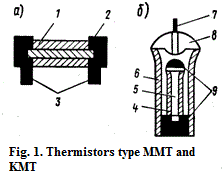
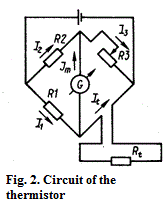
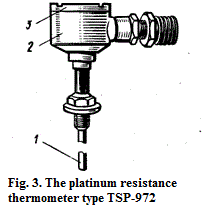

See also:
CONVERTERS, GAUGES, SENSORS
Information, news, advertising

